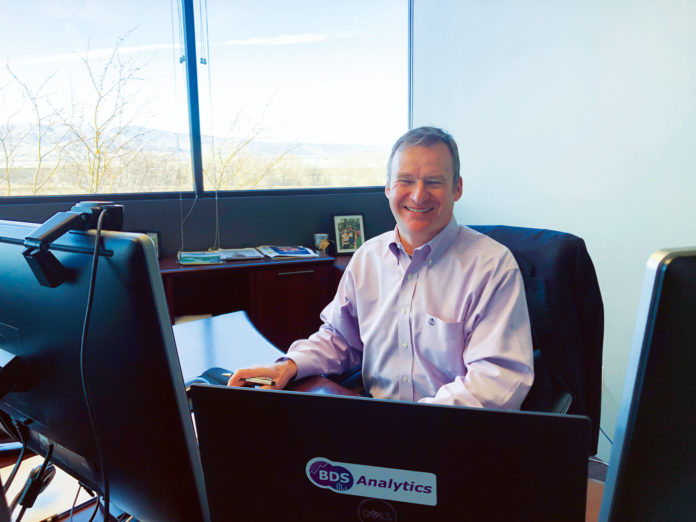When Roy Bingham launched BDS Analytics in 2015, he was a self-proclaimed cannabis novice. He grew up in rural England, where cannabis was both illegal and scarce. But what wasn’t scarce for Bingham was an obsession with data and numbers. Armed with a bachelor’s degree in economics from Lancaster University, he spent years working with numbers and data as a banking professional, financial consultant, and economic advisor in London. In the 1990s, after stints at market-research giants The Nielsen Company and IRI, he struck out on his own and launched SPINS, a data analytics company for the nutrition industry, which he sold several years later.
Then, an acquaintance told him the cannabis industry was on the verge of exploding and no one was providing business intelligence with the level of sophistication for which he was known.
Bingham partnered with Liz Stahura—a widely recognized authority in retail sales analysis and strategic consulting, having worked with Leisure Trends and NPD Group—and together the pair founded BDS Analytics in Boulder, Colorado. He serves as the chief executive officer and she as president.
And he’s no longer a cannabis novice. “Since launching BDS, I have tried vaporizers, flower, concentrates, edibles, and topicals,” he said with a chuckle.
Bingham and Stahura were just what the nascent industry needed, even if cannabis companies didn’t realize it at the time. Just as today, the industry was highly segmented, with each state having its own unique—and uniquely challenging—characteristics. To provide accurate market data, BDS needed to establish extensive relationships and data flow in each state rather than nationally, as the founders were accustomed to doing. In addition, the arduous task of providing actionable insights about consumers, via research into consumer attitudes locally and nationally, lay before them.
With BDS’s veteran technology team, the company quickly defined a plan of attack. Bingham said the regulatory landscape constantly and dramatically changed market by market, so the company opened offices in other states. “California went from being a largely unregulated and unlicensed [medical] market to a regulated, licensed adult-use market, and the rapid transformation there has not been without turmoil,” he said. “Colorado has evolved steadily and now is five times bigger than in 2015. Oregon has had a bumpy ride but now seems to be on a steady growth trajectory, as is Washington, which also had a bumpy ride at the end of medical. Arizona is a healthy, burgeoning medical market, and Nevada is off to an exciting start after a rapid transition to an adult-use market.
“We are seeing tremendous progress in many other states, and federal legalization in Canada is an internationally important development that will represent a significant business opportunity in coming years,” he added.
Ultimately, tracking consumer trends and purchasing data became BDS’s most visible value proposition. When the company launched, most retail cannabis customers were young males. Now the demographic comprises all age groups and genders. There are more female consumers—almost 50 percent of all cannabis purchasers—more Baby Boomers, and more senior citizens, Bingham said.
“Almost every demographic type is making purchases in dispensaries in all states,” he said. “It could be your mother, your sister, your brother.”
He shared some some additional insight.
BDS relies on dispensary data for its analyses, providing insight in return. How does that work?
Dispensaries connect their point-of-sale system to our platform, which takes very little time and effort. The data transfer is simple, and at the present time it is still a free service. The synthesized data enables them to understand, in great detail, their own sales trends, but more importantly compare those trends to the averages in their market and understand fresh opportunities. They can focus on categories where there is growth. They can then match consumer demand in their market and increase customer loyalty as a result of having the best offerings. Also, our data gives dispensaries the tools they need to fine-tune their merchandising, understand how best to price their products, and much more.
Early on we recognized the importance of providing data to National Cannabis Industry Association members to help develop consistent terminology within the industry when it came to categories and subcategories. So, we made GreenEdge available as a benefit for NCIA members. GreenEdge is our retail sales tracking online platform, which provides clients unlimited access to accurate and actionable data about what is selling, when, where, and for how much on a daily, weekly, monthly, quarterly, and annual basis. We’ve received positive feedback from NCIA members about how useful that is.
BDS crunches dispensary data in an ever-expanding list of states. Which states are next?
We are interested in the northeast, especially Massachusetts and surrounding states. Florida is growing rapidly right now. The central Atlantic states, like Maryland, New Jersey, and New York, have huge potential once the regulatory market improves. And we are interested in big Midwest states, all of which have unique characteristics and great potential.
Flower’s market share has been on the decline for years. What’s the situation now?
Wholesale flower prices have declined significantly in most markets except California. Retail prices have also declined, but not by as much. So, margins on flower actually have improved a little.
What about edibles?
Prices for edibles have increased, on average, in most states by a few percentage points, while input prices have decreased. So, margins for edibles have improved, too. Gummies do well in all markets where they are allowed, with leading brands doing extremely well.
And concentrates?
Concentrates are in between the two. There have been declines in concentrate prices, but not like the reduction in input costs—the decreases in wholesale flower. The conclusion: It’s a good time to be a brand. If you are established as a $19.99 product, you don’t have to discount but your inputs have gone way down. Your margins are better. Vapes are very strong, especially in California where they represent 70 percent of all concentrate sales and are growing steadily. The leading brands are doing well and taking large chunks of market share.
CBD is getting a lot of attention since passage of the 2018 Farm Bill. What does that look like from a data perspective?
We see high-priced tinctures rising in popularity, which in many cases involve high-CBD products. High-CBD products in certain categories, like tinctures and topicals, are growing fast.
Micro-dosing is in vogue. What effect is that market trend having, sales-wise?
Micro-dose products are doing well, and we are starting to see progress with alternative ways to introduce THC into the bloodstream, such as sublingual liquids and breath strips. The beverage category overall is not overly exciting, but within the category new types of products are doing well—powdered products that dissolve in liquid and tea, for example.
What does the data say about retail seasonality?
A seasonal pattern is emerging. In most markets we are seeing a seasonal lull in late summer. The third quarter tends not to be as high as the second and the fourth in the Colorado market. It’s hard to say with California and Oregon, as there has been so much turmoil.
With Arizona, we don’t yet have enough long-term experience to come to conclusions. We do see big months and big days, usually around holidays, as well as reliable weekly trends. Friday, for example, is always the big sale day of the week. All sorts of patterns are emerging as this market evolves and we gain historical data to make valuable comparisons.
Based on the data, what advice would you give companies trying to create unique and successful brands?
Understanding the market is essential. The days of being able to just wing it in terms of launching a brand are long gone. Nobody will gain a clear understanding of their market through just talking to friends and family. Instead, consumer-facing brands must engage vigorously with data, from retail sales numbers and trends to insights derived from professional, scientific consumer researchers.
In addition to powerful data, brands must have full confidence in their supply chains. Few things doom brands as quickly as failing to have enough product for dispensary partners. A savvy sales force is vital, too. Relationships with dispensaries are paramount, and your sales team is an important bridge between the product and store shelves. They simply must be constantly engaging with your accounts. In addition, things like smart promotions and product consistency and reliability are important in what is an increasingly competitive marketplace.
Tech and many other long-established sectors embrace data as an essential component of business success. Has cannabis reached that point?
I think it’s fair to say the number-one challenge when we started working with some of our dispensary partners and brands was helping them to understand our service, especially those who hadn’t used similar services in other industries. That is getting easier now as people from other backgrounds get involved with the industry. The relatively small size of the companies in the industry is challenging. Many of them don’t have the financial resources—or more importantly, the staff—to focus on data.
But the industry is catching on to the concept. We hear things like, “BDS has offered up data that has enabled us to recognize an opportunity with a new category or new product line and to be able to shift pricing in our favor.” One retail owner recently said to me, “The actionable data enabled us to realize products we hadn’t been focusing on had great potential, so we redoubled our efforts. It enabled us to understand the impact competitor marketing campaigns might be having. It also empowered our sales force with reliable, accurate, third-party data to help persuade other dispensary owners they needed to carry our products.”
BDS is growing. Your client base has expanded dramatically in the past three years.
We are growing so fast with our current business model. The majority of the top 100 brands in cannabis use BDS Analytics. We have close relationships with hundreds of dispensaries providing us their POS data and using our service to improve their performance. We have thirty-five employees now, and we have raised three rounds of capital, with increasing valuations.
We’re focused on adding new clients and new states and territories while also enhancing our existing POS analytics services and our Industry Intelligence division. Also, we are investing resources to expand our Consumer Insights division. We’re not looking hard at strategic changes yet.
Where do you see the cannabis market in the next three years?
By 2022 we expect a global market of $32 billion, and North America will represent 90 percent of the total. We believe federal legalization could happen by 2021.













[…] growth, with New York and New Jersey each projected to be $2.5-billion markets by 2027,” said Roy Bingham, co-founder and chief executive officer at BDSA, a market research and analytics firm. The company […]